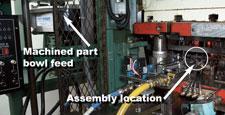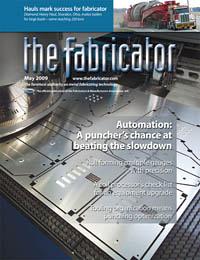Senior Editor
- FMA
- The Fabricator
- FABTECH
- Canadian Metalworking
Categories
- Additive Manufacturing
- Aluminum Welding
- Arc Welding
- Assembly and Joining
- Automation and Robotics
- Bending and Forming
- Consumables
- Cutting and Weld Prep
- Electric Vehicles
- En Español
- Finishing
- Hydroforming
- Laser Cutting
- Laser Welding
- Machining
- Manufacturing Software
- Materials Handling
- Metals/Materials
- Oxyfuel Cutting
- Plasma Cutting
- Power Tools
- Punching and Other Holemaking
- Roll Forming
- Safety
- Sawing
- Shearing
- Shop Management
- Testing and Measuring
- Tube and Pipe Fabrication
- Tube and Pipe Production
- Waterjet Cutting
Industry Directory
Webcasts
Podcasts
FAB 40
Advertise
Subscribe
Account Login
Search
Measurement, assembly, and welding: Ultra Tool's quest for in-die perfection: Part II
Eliminating secondaries with in-die assembly
- By Tim Heston
- June 7, 2009
- Article
- Bending and Forming

Figure 1: Technicians in Ultra Tool & Manufacturing’s pressroom have performed in-die measurement, springback compensation, assembly, and welding—a rare accomplishment.
Editor's Note: The following is the second article in a three-part series on in-die operations at Ultra Tool & Manufacturing. Part I covers in-die measurement and springback compensation. Part III covers the company's in-die projection welding setups.
Ultra Tool & Manufacturing has made great strides toward errorproofing, eliminating secondary operations, and drastically reducing the labor content for some seriously complex work. The Menomonee Falls, Wis., company performs in-die measurement, springback compensation, assembly, and welding—a rare offering for a U.S. metal stamper (see Figure 1).
The effort began when Ultra launched its own sensor lab eight years ago. One of its first projects, covered in Part I, involved sensors and other in-die mechanisms that measured and adjusted for out-of-tolerance bend angles. With that experience under its belt, the company pursued another in-die operation: assembly. The result? Ultra saved its customer $432,000 a year.
Lessons Learned
"Without the knowledge gleaned from that in-die measurement and control tool, we would not have had the confidence to tackle a project like this," said Brad Schmit, manufacturing technology manager.
This prior application not only measured bend angles on parts, but also attempted to correct them if they were out of tolerance. This required a multistation approach within a progressive die. Notorious for springback issues, bend angles were formed at the first station and measured in subsequent stations to determine if an altered restrike was necessary. If it was, motors would adjust elements within the restrike die. After the restrike, sensors would inspect to see if the parts were brought into tolerance, and if they weren't, a signal would be sent to pneumatically activate a scrap chute underneath the die, where the part fell through. The chute would stay in position until the control verified good parts were emerging from the tool again.
This all took serious control coordination, not to mention a steep learning curve. Fortunately, much of the knowledge gained, Schmit said, could be carried over to other in-die operations, assembly included.
Eliminating Secondary Assembly
In-die assembly landed on Ultra's radar with a job requiring about 6 million parts a year, to be run in a 45-ton, straight-side mechanical press from Minster. The assemblies included round, dime-sized disks, one on top of the other. A round point in the center of one part was staked into a round pierced hole of the other.
Still running today, the job is formed on a progressive die with about 20 stations. As one part is trimmed and formed, the mating part is bowl-fed on two tracks that shuttle the parts underneath the strip into location, just underneath the assembly station.
At the next station, which borrows from the company's earlier experience, a digital sensor verifies the parts are mated correctly. If they aren't, a signal is sent to pneumatically activate a scrap chute to catch those bad parts as they are cut off at the final prog-die station. The chute doesn't leave until the sensors verify that good assemblies are emerging from the tool again (see Figure 2 and Figure 3).
As Schmit explained, "These are very small parts, and we might have 5,000 in a box." Finding a bad part is the stamping equivalent of finding a needle in a haystack, so separating good parts from bad in-process is vital.

Figure 2: This in-die assembly setup used a bowl feed to shuttle parts into position for staking into a mating part.
All About Timing, Again
As with Ultra's previous application, timing is everything, and it all comes back to the press crank angle. A resolver system hooks to the press crankshaft, and because "the entire monitoring system hinges on crank angle, it's imperative that this system [hooked to the press crankshaft] stays functioning properly," Schmit explained. "These are very robust systems. So unless you break a chain or something catastrophic happens with the crank, you're pretty much fail-safe."
The bowl-fed part had to be shuttled underneath the strip when the die was just starting to open. During process development, Ultra's engineers opened and closed the die set slowly. When a mechanical action needed to occur, they would note the precise crank angle to use in the program. When this exact crank angle was reached, a limit switch would be activated to initiate the mechanical action. Each sensor and limit switch had to be programmed individually, as well as outputs to pneumatic cylinders—and, again, every line in these programs hinged on that press degree angle.
"Obviously, you can't shuttle a part beneath the strip when the die is closed," Schmit said. "So, you need to wait for the stripper to come off of the stripper material. The material lifts up with the material lifters, and that gives you the time you need to shuttle that part underneath the strip."
The component could be bowl-fed fairly easily, Schmit added, but there were a few challenges, particularly considering how small and lightweight the components were. The bowl-fed part shuttled to a nest area, directly below the assembly station. But because pneumatic components are close to the nest area, engineers had to be sure that unintentional air circulation did not blow the light parts out of alignment (or, for that matter, completely out of the press). Sensors also had to ensure both tracks were filled with components continuously during operation. With no parts in those tracks, the press operation had to shut down and signal the operator.
Another issue was monitoring the actual distance the tool closed, which determines the degree the parts are staked together to make a mated assembly with a consistent height. It's an issue that proved that sensors aren't the solution for everything. Ultra's team had considered integrating analog sensors to verify the part height, but that would have added more complexity and expense to the operation. So ultimately engineers incorporated simple die stops so that the tool closed at a precise point every stroke. "Using those very simple die stops was sufficient to achieve the quality we needed," Schmit said.
Controller Logic
Ultra engineers use what's called shift register logic in the process monitor system. The shift register acts like a sequencer that counts every press stroke and coordinates motions based on those counts. More important, it uses this stroke count to coordinate movements of different elements at precise times to prevent errors.
For instance, when a bad mated part reaches the station with a digital sensor, that part won't be cut off for another three stations. If a scrap chute were sent immediately underneath the cutoff station, it would take a few good parts before collecting the bad part. So, instead of the sensor signaling the press controller to send the scrap chute immediately, the controller's shift register "counts" three press strokes and ensures the scrap chute is in place only when the bad part reaches the cutoff station.
The controller's shift register follows a kind of "if-then-only" logic, so to speak, all based on those stroke counts: If a signal from a sensor is turned "on" at 180 degrees into the press stroke (meaning the part isn't assembled correctly), then signal the scrap chute only after counting three press strokes, when the bad part reaches the cutoff station.
Ultra used what was then a new controller from Link Systems with this kind of integrated shift-register logic. "It's a logic technology that before this was not available to stampers," Schmit said.
On to the Next Level
By the end of 2006, Ultra had overcome the technical hurdles of two in-die operations, and saved customers thousands by eliminating secondary operations. But Schmit conceded that the company experienced significant challenges, including cultural ones. Sure, the in-die operations eliminated secondaries, but it also created some complex tooling setups on the floor. Some pressroom personnel had common—and warranted—concerns: The more bells and whistles an operation has, the greater chance there is for something to go wrong, right? At the time wires abounded around the press tooling and, in retrospect, the shop was in dire need of simplification and organization.
So Ultra called in a consultant who has garnered a reputation for his knowledge of pressworking sensors: George Keremedjiev of Technow Education Services. "We found that we were by no means world-class stampers when it came to sensors," Schmit said.
Job Specs
Part: Munitions subcomponent for defense industry
Part material: Quarter-hard cold-rolled steel
Thickness: 0.015 in.
Quantity: 6,000,000 per year
Press: 45-ton mechanical press operating at 120 strokes per minute
About the Author

Tim Heston
2135 Point Blvd
Elgin, IL 60123
815-381-1314
Tim Heston, The Fabricator's senior editor, has covered the metal fabrication industry since 1998, starting his career at the American Welding Society's Welding Journal. Since then he has covered the full range of metal fabrication processes, from stamping, bending, and cutting to grinding and polishing. He joined The Fabricator's staff in October 2007.
Related Companies
subscribe now

The Fabricator is North America's leading magazine for the metal forming and fabricating industry. The magazine delivers the news, technical articles, and case histories that enable fabricators to do their jobs more efficiently. The Fabricator has served the industry since 1970.
start your free subscription- Stay connected from anywhere

Easily access valuable industry resources now with full access to the digital edition of The Fabricator.

Easily access valuable industry resources now with full access to the digital edition of The Welder.

Easily access valuable industry resources now with full access to the digital edition of The Tube and Pipe Journal.
- Podcasting
- Podcast:
- The Fabricator Podcast
- Published:
- 04/16/2024
- Running Time:
- 63:29
In this episode of The Fabricator Podcast, Caleb Chamberlain, co-founder and CEO of OSH Cut, discusses his company’s...
- Trending Articles
AI, machine learning, and the future of metal fabrication

Employee ownership: The best way to ensure engagement

Steel industry reacts to Nucor’s new weekly published HRC price

Dynamic Metal blossoms with each passing year

Metal fabrication management: A guide for new supervisors

- Industry Events
16th Annual Safety Conference
- April 30 - May 1, 2024
- Elgin,
Pipe and Tube Conference
- May 21 - 22, 2024
- Omaha, NE
World-Class Roll Forming Workshop
- June 5 - 6, 2024
- Louisville, KY
Advanced Laser Application Workshop
- June 25 - 27, 2024
- Novi, MI



























